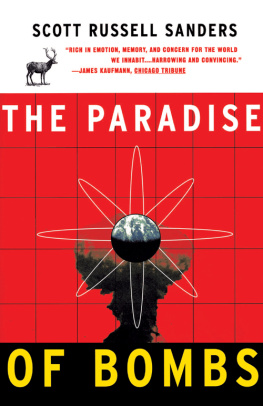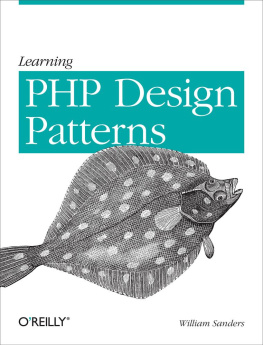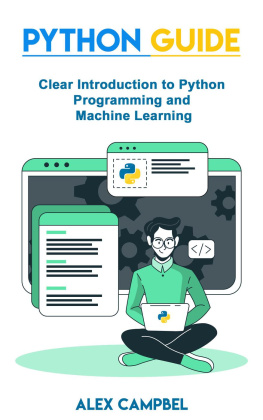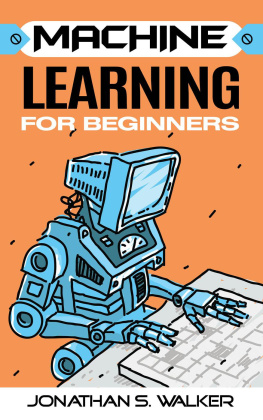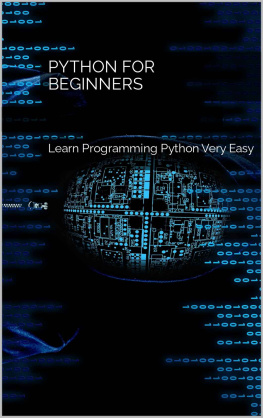Sanders - PYTHON: 2 books in 1 : Learn python programming for beginners and machine learning
Here you can read online Sanders - PYTHON: 2 books in 1 : Learn python programming for beginners and machine learning full text of the book (entire story) in english for free. Download pdf and epub, get meaning, cover and reviews about this ebook. year: 2020, genre: Computer. Description of the work, (preface) as well as reviews are available. Best literature library LitArk.com created for fans of good reading and offers a wide selection of genres:
Romance novel
Science fiction
Adventure
Detective
Science
History
Home and family
Prose
Art
Politics
Computer
Non-fiction
Religion
Business
Children
Humor
Choose a favorite category and find really read worthwhile books. Enjoy immersion in the world of imagination, feel the emotions of the characters or learn something new for yourself, make an fascinating discovery.

PYTHON: 2 books in 1 : Learn python programming for beginners and machine learning: summary, description and annotation
We offer to read an annotation, description, summary or preface (depends on what the author of the book "PYTHON: 2 books in 1 : Learn python programming for beginners and machine learning" wrote himself). If you haven't found the necessary information about the book — write in the comments, we will try to find it.
PYTHON: 2 books in 1 : Learn python programming for beginners and machine learning — read online for free the complete book (whole text) full work
Below is the text of the book, divided by pages. System saving the place of the last page read, allows you to conveniently read the book "PYTHON: 2 books in 1 : Learn python programming for beginners and machine learning" online for free, without having to search again every time where you left off. Put a bookmark, and you can go to the page where you finished reading at any time.
Font size:
Interval:
Bookmark:
PYTHON
2 BOOKS IN 1 :
LEARN PYTHON PROGRAMMING FOR BEGINNERS AND MACHINE LEARNING
WILLARD D. SANDERS
Copyright 2020 - All rights reserved .
The content contained within this book may not be reproduced, duplicated or transmitted without direct written permission from the author or the publisher. Under no circumstances will any blame or legal responsibility be held against the publisher, or author, for any damages, reparation, or monetary loss due to the information contained within this book. Either directly or indirectly.
Legal Notice: This book is copyright protected. This book is only for personal use. You cannot amend, distribute, sell, use, quote or paraphrase any part, or the content within this book, without the consent of the author or publisher.
Disclaimer Notice: Please note the information contained within this document is for educational and entertainment purposes only. All effort has been executed to present accurate, up to date, and reliable, complete information. No warranties of any kind are declared or implied. Readers acknowledge that the author is not engaging in the rendering of legal, financial, medical or professional advice. The content within this book has been derived from various sources. Please consult a licensed professional before attempting any techniques outlined in this book.
By reading this document, the reader agrees that under no circumstances is the author responsible for any losses, direct or indirect, which are incurred as a result of the use of information contained within this document, including, but not limited to, errors, omissions, or inaccuracies.
THIS BOOK INCLUDES
BOOK 1:
LEARN PYTHON PROGRAMMING FOR BEGINNERS:
A Beginners Guide to Comprehending Python. Develop Your Programming Skills and Learn All the Tricks with This Crash Course.
BOOK 2:
PYTHON MACHINE LEARNING
The Complete Beginners Guide to Deep Learning with Python. Learn How to Use Scikit-Learn and Pandas.
LEARN PYTHON PROGRAMMING
FOR BEGINNERS:
Table of Contents
PYTHON MACHINE LEARNING
Table of Contents
LEARN PYTHON PROGRAMMING FOR BEGINNERS:
A Beginners Guide to Comprehending Python. Develop Your Programming Skills and Learn All the Tricks with This Crash Course.
WILLARD D. SANDERS
T he following chapters of this book will discuss Python as a programming language. Each chapter will take you on an in-depth journey into understanding the Python programming language. This book was written to provide the reader with an understanding of Python. The author of this book has conducted thorough research through sources believed to be reliable to come up with the relevant information on the topic.
Go ahead and read through the entire book, get the knowledge, and be informed about the key things that you need to know about this particular topic. Python is a programming language that is often recommended for beginners to try messing up things and falling in love with programming. One of the major reasons for the widespread popularity of Python is its simplicity and the power of making things done with less code. Even after the entrance of tens of programming languages in the past decade python doesn't lose its charm and we are pretty confident that it is going to stay.
This book is primarily for people who are relatively new to programming and, more specifically, those who want to discover the world of Python. This book will take you through the fundamentals of programming and Python.
WHAT IS PYTHON

P ython is an awesome decision on machine learning for a few reasons. Most importantly, it's a basic dialect at first glance. Regardless of whether you're not acquainted with Python, getting up to speed is snappy if you at any point have utilized some other dialect with C-like grammar.
Second, Python has an incredible network that results in great documentation and inviting and extensive answers in StackOverflow (central!).
Third, coming from the colossal network, there are a lot of valuable libraries for Python (both as "batteries included" an outsider), which take care of essentially any issue that you can have (counting machine learning).
However, here's the caveat: libraries can and do offload the costly computations to the substantially more performant (yet much harder to use) C and C++ are prime examples. There's NumPy, which is a library for numerical calculation. It is composed of C, and it's quick. Therefore, each library out there that includes serious estimations utilizes itevery one of the libraries recorded next utilizes it in some shape. On the off chance that you read NumPy, think quickly.
In this way, you can influence your computer scripts to run essentially as quickly as handwriting them out in a lower level dialect. So, there's truly nothing to stress over with regards to speed and agility.
Python is one of the most important programming languages nowadays, being a general-purpose language.
With this language, you can create a huge and varied amount of applications, because it allows you to create different kinds of applications since it doesn't have a defined purpose.
Since computers were first invented, many people have had the job to make them more useful. To make this happen, there are a ton of programming tools that have been developed over the years to turn the instructions the computer is given into code that the computer can execute. When this first started, assembly language was the main type. While it did allow you to create programming that was tailored and then optimized for the low memory systems of that time, it was hard to learn, read, and maintain and only a few people could use it.
As computer technology grew and many systems became more complex, the programming languages needed to change as well. Some higher-level languages including Lisp, Cobol, and Fortran were produced to produce punch cards which the computers were able to read and then execute the instructions that were found on the card. Programming with this kind of tool was a lot easier than the languages in the past, allowing more people to write the complex programs they needed.
As time started to go on, there were a lot of improvements that were made to some of the technology that we are working with now, and it has resulted in a lot of better storage methods when it comes to our programs and more. For example, some of those punch cards have been replaced with a type of magnetic tape, and then it was all moved over to work with a disc drive. As these new inventions came out, the tools to work on these programs improved as well.
Basic was one of the first coding languages that was designed to be easy to read through and this one was developed in the 1960s. Then in the 1970s, we saw the introduction of Pascal and C, and these became tools that helped us to get a really simple and structured kind of programming language that would help a programmer to get the efficient code that they want. You will find that the structured languages like these would not have to rely on the go-to statement found in some of the other languages. Instead, these programs would rely on a flow that has features including conditional statements, functions, and loops like we will talk about later in this guidebook. These features were nice because they would allow a new programmer to make their applications with the help of standalone reusable routines, which would then be able to lower the amount of time that it would take to develop the program, and even debug it so that the program would work the way that you would like.
Next pageFont size:
Interval:
Bookmark:
Similar books «PYTHON: 2 books in 1 : Learn python programming for beginners and machine learning»
Look at similar books to PYTHON: 2 books in 1 : Learn python programming for beginners and machine learning. We have selected literature similar in name and meaning in the hope of providing readers with more options to find new, interesting, not yet read works.
Discussion, reviews of the book PYTHON: 2 books in 1 : Learn python programming for beginners and machine learning and just readers' own opinions. Leave your comments, write what you think about the work, its meaning or the main characters. Specify what exactly you liked and what you didn't like, and why you think so.


